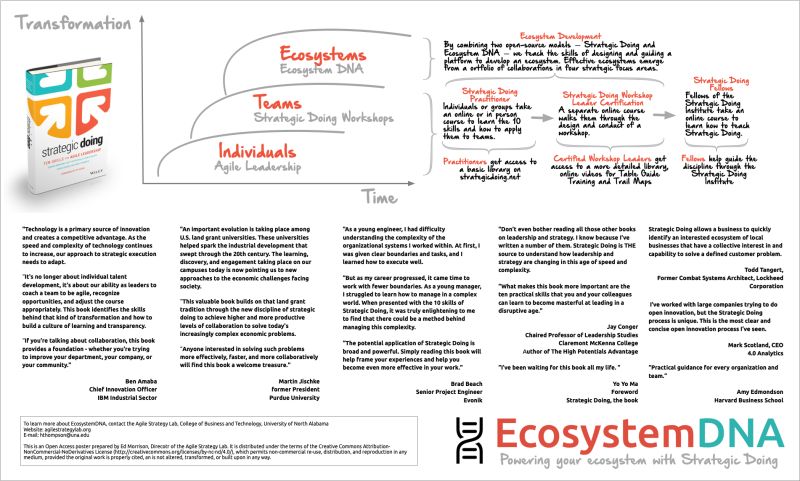Scaling the Application of Strategic Doing into Ecosystem Building
In 1992, a physicist in Singapore opened my eyes to the power of networks. A Ph.D. from MIT, he had recently left one of our federal labs. He was chief technology officer for a start-up Internet company, my client.
THE LUNCH THAT CHANGED EVERYTHING
At lunch, I shared what I had been seeing in my consulting work: the growing impacts of networks on global competitiveness.
Jonathan shared two pieces of advice.
First, he told me to focus on the Internet, our first interactive mass medium. “It will change everything.” (This was a year or so before Netscape released the first commercial browser.)
Next, he told me to study open source software development. I was clueless, so he gave me a couple of books.
I have been walking down this path for 30 years. I’ve focused on developing networks for new solutions to wicked problems: from collaborations among life scientists in NASA to reducing teenage homicides in Flint.
SOME LESSONS
Here are some insights from my journey:
>> Innovation is a process guided by teams — innovating networks of individuals. These teams self-organize. They manage collaboration and recombinant innovation processes: linking, leveraging, and aligning available assets to create new value.
>> Innovating networks take time and trust to build. They emerge from a reliable process of testing ideas and doing work together: aligning their words with commitments “to do”.
>> Conversations link members of the team together. The conversation is the core innovation technology, but most people are miserable at managing conversations.
>> Successful collaborations emerge from conversations with a predictable, hidden structure. They relentlessly focus on doing the doable.
>> Designing and guiding these conversations take ten simple but not easy skills. Mastery comes with practice. (We have distilled these skills into Strategic Doing.)
>> No one is equally good at all ten skills, so solving complex problems requires cognitively diverse teams.
PURDUE: TESTBEDS FOR STRATEGIC DOING
When I came to Purdue in 2005, I struck a deal. Purdue provided me with the resources to learn how to test, validate, and teach Strategic Doing. If successful, we agreed to open-source what we were learning. Over a decade, we developed the insights we needed to learn how to teach Strategic Doing.
UNA: SCALING STRATEGIC DOING
I retired from Purdue in 2019. Large research universities have a lot of advantages, but speed is not one of them. The University of North Alabama has the largest business school in Alabama and a first-in-class digital infrastructure to support its students. With this backbone, we are scaling Strategic Doing globally.
KAUFFMAN FOUNDATION: APPLYING STRATEGIC DOING TO ECOSYSTEMS
Nine months ago, the Kauffman Foundation approached me with a challenge. Could we scale the application of Strategic Doing into ecosystem building?
Five weeks ago, we decided the answer is, “Yes”.
Now, we are continuing down that path.


The Founder of the Lab at UNA and co-author of Strategic Doing: 10 Skills for Agile Leadership, Ed’s work has focused on developing new models of strategy specifically designed to accelerate complex collaboration in networks and open innovation. He is the original developer of Strategic Doing.
